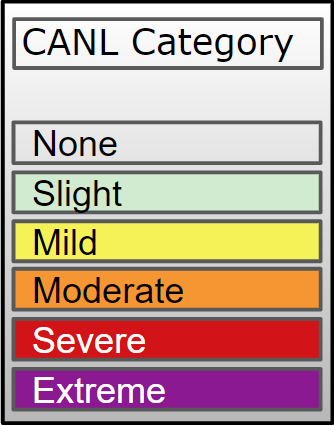
A strong cold front sweeping across the Northern Plains may bring snow showers and snow squalls from eastern Montana to north-central Nebraska, with blizzard conditions possible in eastern North Dakota and northwestern Montana. Heavy snow is expected to persist downwind of the Great Lakes. Snow showers will spread up the East Coast across the Mid-Atlantic and Northeast coasts. Read More >
|
Cold Advisory For Newborn Livestock (CANL) The CANL graphics below show the risk of cold exposure to newborn livestock. The risk is related to wind chill temperature, precipitation, and humidity, and ranges from "NONE" for no risk, to "EXTREME" for rare and particularly dangerous situations. For more information click here for the product fact sheet. The images below are each valid for a 6 hour time period out to 72 hours. Click on the images to expand and see the forecast valid time. The CANL images are updated at least twice daily at 5 am and 5 pm.
|
|
6-hr Liquid Equivalent Precipitation Accumulation
|
|
6-hr Maximum Sky Cover
|
|
6-hr Minimum Wind Chill
|
Based on our research and feedback from the ranching community, the following were identified as hazardous weather elements that increased risk of problems or death to exposed newborns:
The criteria used to generate the forecasts from the tab above is seen below:

The CANL system was created by the NOAA/National Weather Service in Glasgow, Montana; Dr. Larry Kalkstein at the University of Miami and Dr. Katrina Frank at the University of Delaware. Dr. Kalkstein is a leading researcher on weather effects on humans (biometeorology), and Dr. Frank has a background in animal sciences and climatology (bio-climatologist). The system is designed to indicate weather conditions dangerous to newborn livestock. The criteria for this system were derived from interviews with ranchers and from published scientific research on animal health.
We are targeting livestock that are less than 24 hours old because these animals are least able to regulate their body temperature and therefore most susceptible to the cold. Also, after several hours, producers may have had a chance to get to the animal, dry it off, and provide shelter as needed.
Detailed graphics will be available on the local office websites.
Feedback is appreciated. You can provide feedback or ask questions about the system by calling Tanja Fransen at the NWS Portland office at 503-261-9246, or emailing her at tanja.fransen@noaa.gov. Your local WFO is available as well.
This system was developed by the University of Miami and the National Weather Service in Glasgow under a sub-award with the University Corporation for Atmospheric Research (UCAR) under Cooperative Agreement No. # S08-68874 with the National Oceanic and Atmospheric Administration (NOAA) and U.S. Department of Commerce.
|
|
|
|
|
|
|
|
|
|
|
|
|
|
|
|
|
|
|
|
|
|
|
|
|
|
|
|
|
|
|
|
|
|
|
|